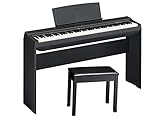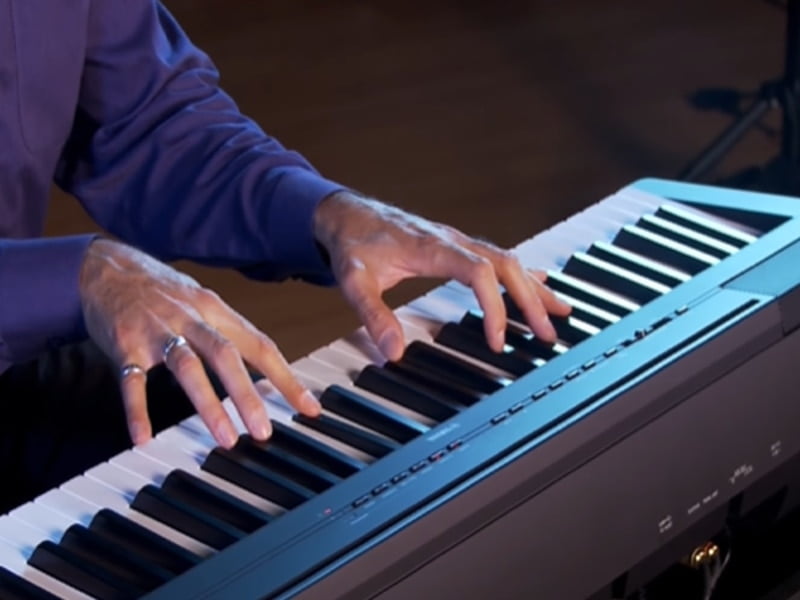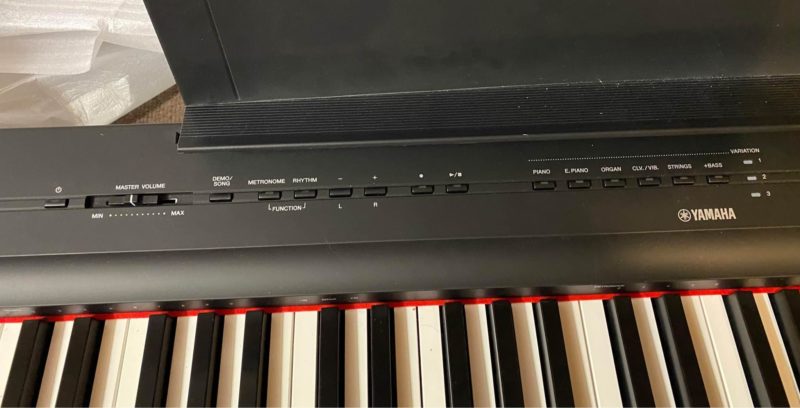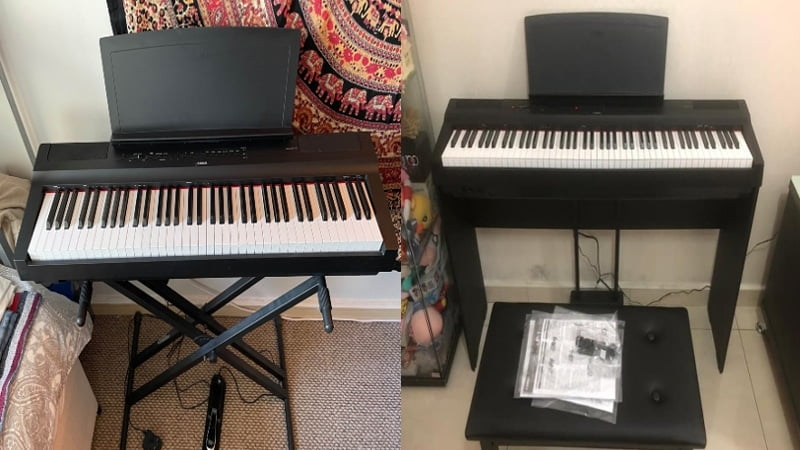Learn the pros and cons of both pianos and which is the best pick in this Yamaha P-121 vs P-125 review.
The Yamaha “P” line is one of the most popular digital piano collections for beginners. The pianos are affordable but come with rich tones and various features that would make them great for any novice and beginner pianist.
And a common debate with this collection is the Yamaha P-121 vs Yamaha P-125 debate. These are some of the most affordable options in Yamaha’s portable digital piano collection. And while they have a similar feature set, I found that the Yamaha P-125 is the better option after many tests and a ton of research.
But even if I prefer the Yamaha P-125, the Yamaha P-121 still comes with certain pros that would make it the better pick for some pianists. And in this Yamaha P-121 vs P-125 comparison, I’ll go over the good and bad of both pianos.
That way, it will be much easier for you to figure out which piano is the best option for you!
Yamaha P-121 vs P-125: Comparison Chart




Last update on 2025-04-13 / Affiliate links / Images from Amazon Product Advertising API
Yamaha P-121 vs P-125: A Head-to-Head Comparison
Since these pianos come from the same brand and collection, I figured the best way to compare the two would be to put their features up against each other. And after testing the feel, tone, and piano features of both instruments, the Yamaha P-125 came out on top. The final score in this comparison was 3-1 in favor of the P-125.
I chose the P-125 as the winner because it had a better feel and came with a more versatile feature set. But let’s take a closer look at both pianos so you can figure out which one serves your needs the best.
Feel
The winner: P-125
The first feature I looked at with these two pianos was the feel. When buying a digital piano, it’s ideal to find one with a realistic feel close to that of an acoustic piano. The P-125 came out on top in this comparison because it has 88 keys, which means you have the full piano range when playing this instrument.
Besides the number of keys, both pianos have the same feeling due to the identical hammer action system. So, if you don’t mind the smaller range on the P-121, it could be a great option because the keys still have a realistic weight to them.
+Number of Keys
This is the only difference between the two pianos in terms of feel. The Yamaha P-125 is Yamaha’s most affordable full-key portable digital piano. So, you’ll find 88 keys on this piano, which is exactly the same number of keys you’ll find on any grand piano.
This gives you a full range of notes when playing the P-125. The P-125 is great for beginners and novice pianists as you have all the notes you’d expect from an acoustic piano. That way, you won’t have to worry about running out of keys when playing certain pieces.
The Yamaha P-121 only comes with 73 keys, which means you won’t have as full a range. This isn’t that big of a deal for beginners, as you won’t need all the notes when starting. However, there’s no doubt that the P-121’s range is limited.

+Hammer Action
Both of these pianos have the same hammer action system. I was happy to discover that they both have the Graded Hammer Standard or GHS system, that’s a staple of many Yamaha pianos. So, both of these pianos have a realistic weight to them and do a great job of emulating the weight of an acoustic piano’s keys.
This is because the GHS system accounts for the subtle weight differences you’ll find on an acoustic piano. Both the P-125 and the P-121 have slightly heavier keys on the lower end and lighter keys on the higher end, which is a great feature to have, especially considering that both of these pianos are fairly affordable.
+Key Texture
One letdown I had with both pianos was the key texture. Both of these Yamaha pianos use glossy plastic keys. This means that the keys feel a bit slippery, especially if you’re used to the texture on an acoustic piano.
It would have been great to see wooden or textured keys on these pianos. But considering their price, it’s easy to see why Yamaha decided to keep the keys glossy.
Tone
The winner: Tie
I found that these pianos have some of the richest and brightest piano tones in their price range. I was honestly surprised at the quality of the piano and other tones on these instruments. Since they use the same tone engine and have the exact same sound library, I couldn’t pick a winner in this category and decided to award the point to both pianos.
+Tone Generator
To start, both of these pianos use the Pure CF Sound Engine. This is not the newest Yamaha tone engine available, but it’s still one of their best. Even if both pianos rely on samples that you trigger whenever you press a key, the sound quality from the tone engines far exceeds their price range.
The reason the Pure CF Sound Engine produces such great tones is the quality of its samples. When recording the samples, Yamaha used the most advanced equipment to capture the true sound of the pianos. On top of that, Yamaha recorded sounds from their CF Grand Pianos, some of the industry’s most popular options.
So, if you want a piano that has high-quality voices, both the P-121 and the P-125 do the job.
+Sound Library
Digital pianos are known for a fairly limited sound library. That’s why I was happy to learn that both of these pianos have a sound library with 24 different voices. Aside from the various piano tones on the piano, you can try out the electric piano, bass, and strings voices. That way, you get a fair amount of variety in your tones.

Piano Features
The winner: Yamaha P-125
The last comparison point I had for these two pianos was the piano features. And again, the Yamaha P-125 came out on top. This is because the P-125 comes with more playing modes than the P-121, making it the more versatile option.
+Playing Modes
When you use these pianos, you’ll find that they both have split and duo modes. This is a really cool feature, as it allows you to use the pianos in various ways. For example, you can use split mode to divide the piano into two zones that each has its own voice. So, you can load a bass voice on the left hand and an organ voice on the right hand, which makes it much easier to play the accompaniment for a vocalist or fill up sonic space in a band.
With duo mode, you can easily do piano lessons or play duets. This is because the mode divides the piano into two separate mini pianos with the same voice and timbre. That way, you and another pianist can play together without worrying about playing the wrong notes.
That said, since the Yamaha P-121 has fewer keys, split and duo modes don’t work as well. On top of that, the P-121 lacks one very important mode, which you can find on the P-125: dual or layering mode.
This mode allows you to blend two voices together. This means you can experiment with various combinations until you find the one that suits your playing style and tastes. So, the Yamaha P-125 is by far the more versatile option between the two and would be a better pick for pianists who play a lot and enjoy experimenting.
Yamaha P125 vs P-121: The Similarities
It should come as no surprise that these pianos share many similarities. You can see that P-125 as the exact same piano as the P-121, except with more keys. This is because the P-121 is the entry-level model in the portable line, while the P-125 is one step above the P-121 in the hierarchy.
So, you can expect the same tones, feel, and even effects on both pianos. In fact, both pianos have the same maximum polyphony of 192. That means you won’t have trouble playing wide and spread-out chords, even if you’re blending multiple voices together.
Note that the 192-note maximum polyphony means a bit more on the P-121 because it has fewer keys. However, this doesn’t really make a difference in the piano’s performance.
If you’re on a tight-budget and don’t mind a limited range of notes, then the Yamaha P-121 is a great option. It has some of the best sounds in its price range, offers a realistic feel, and comes with a fair amount of piano features.
But if you want the full piano range when practicing or performing, the P-121 won’t be a good option. Instead, you might be better off taking a step up and getting the P-125. Even if it’s more expensive, it offers a lot of value for the money and is by-far one of my favorite picks in this price range.
Quick Rundown of the Yamaha P-121
- A lighter and more portable version of the Yamaha P125
- A fully weighted digital piano with 73 full-sized piano-style keys
- GHS weighted action is heavier in the low keys and lighter in the high keys, just like an acoustic piano
- The pure CF sound engine faithfully reproduces the tone of the acclaimed Yamaha 9' CFIIIS Concert Grand piano
- USB to host connectivity with MIDI and audio transfer means you only need one Cable to connect to your music-making software
Last update on 2025-04-14 / Affiliate links / Images from Amazon Product Advertising API
Quick Rundown of the Yamaha P-125
- Includes P125B digital piano, L125B furniture stand, BB1 wooden bench
- A fully weighted digital piano with 88 full sized piano style keys
- GHS weighted action is heavier in the low keys and lighter in the high keys, just like an acoustic piano
- The pure CF sound engine faithfully reproduces the tone of the acclaimed Yamaha 9' CFIIIS Concert Grand piano
- USB to host connectivity with MIDI and audio transfer means you only need 1 Cable to connect to your music making software
Last update on 2025-04-13 / Affiliate links / Images from Amazon Product Advertising API
Product Videos
Related Articles to Yamaha P125
- Yamaha P150 vs P125: The Battle of the P-Series Models
- Yamaha P125 vs CLP 625: Can a Beginner’s Digital Piano Match the Clavinova?
- Yamaha P125 vs Roland FP 60: Which is the Better Investment?
- Yamaha P125 vs Korg LP 380: Which Piano Is Better for Your Needs?
- Yamaha P125 vs P85: Can the Outdated Digital Piano Beat the Newer One?
- Yamaha P125 vs DGX 670: Which Piano Comes Out on Top?
- Yamaha P125 vs Korg SP 280: Which is the Better Beginner’s Digital Piano?
- Yamaha P-255 vs P-125: Finding the Better Option for Beginners
- Yamaha P125 vs YDP S34 Comparison: Does the Portable P125 Hold Up Against a Console Digital Piano?
- Yamaha P125 Vs YDP 164: Should You Get A Console Or Digital Piano?
- Yamaha YDP 103 Vs P125: Should You Get a Portable or Console Digital Piano?
- Yamaha P125 Vs Kawai ES110 Comparison: Which Is The Best Portable Digital Piano
- Yamaha P125 vs Casio PX S1000: Which Digital Piano Is Worth Your Money?
- Casio PX-870 Vs Yamaha P-125: Should You Get A Portable Or Console Digital Piano?
- Alesis Recital Vs Yamaha P125: Which Is The Right Pick For You?
- Yamaha P45 VS P115: Which P-Series Newbie Gives You More Value for Money?
- Alesis Recital Pro vs Yamaha P125 Comparison: Which Is The Best Portable Digital Piano?
- Alesis Prestige Artist vs Yamaha P125 Comparison: Why the Yamaha P125 Is the Better Investment
- Yamaha P125 vs Casio PX-770 Review: Why the Yamaha P125 Beats Out the Casio Console Digital Piano
- Yamaha P125 vs DGX 660 Comparison: Can the P125 Hold Its Own Against the DGX 660?
- Yamaha P125 vs Roland FP-30X Review: Why the Roland FP-30X Comes Out On Top
- Yamaha P125 vs P515 Review: Why the Yamaha P515 Is the Better Investment
- Yamaha P115 vs P125 Review: Can the P125 Beat Out Its Predecessor?
- Yamaha P125 vs Roland FP30: A Close Battle Between Two Great Digital Pianos
- Yamaha P45 vs P125: Why the Yamaha P125 Is the Better Pick for Pianists
- Yamaha P71 vs P125: Why the Yamaha P125 Is the Better Investment
References:
- Yamaha P-121: https://www.sweetwater.com/store/detail/P121BK–yamaha-p-121-digital-piano-black
- Yamaha P-125: https://usa.yamaha.com/products/musical_instruments/pianos/p_series/p-125/specs.html#product-tabs
Lulacruza is an electronic folk duo operating at the junction of the hypermodern and the ancient. Our music weaves together hypnotic female singing, South American folk instruments and electronic processing, while channeling pulsating waves from the source of creation.
Lalucruza is also a community where you can connect with other music lovers to collaborate, exchange ideas and share knowledge. A platform for who wants to learns the basics of playing piano, guitar, drum masters’ technique, etc.. is the premise of our website.
